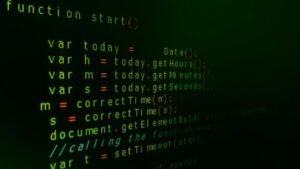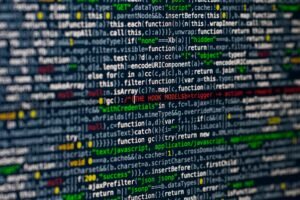Make App in Python
Python is a versatile programming language that can be used to develop a wide range of applications, including mobile apps. With its simple syntax and vast library support, Python offers developers an efficient platform for creating robust and scalable applications. In this article, we will explore the steps to make an app in Python and unleash the power of this popular programming language.
Key Takeaways:
- Python is a versatile programming language suitable for app development.
- Python offers a wide range of library support for building robust applications.
- Developing an app in Python involves following a step-by-step process.
To make an app in Python, you need to follow a structured approach that includes planning, designing, coding, testing, and deploying. The first step is to identify the purpose and functionality of the app. Once you have a clear vision, you can move on to designing the user interface and planning the app’s features.
*Python* provides a variety of frameworks such as Flask and Django that simplify the process of building web applications. These frameworks abstract away the complexities and allow developers to focus on writing the core functionality of the app.
1. Planning and Designing
Before diving into coding, it’s crucial to plan and design your app. Define the scope of the project, create a blueprint of the user interface, and decide on the features and functionalities you want to incorporate. This step acts as a roadmap for the development process and ensures that you have a clear vision for your app.
**Wireframing** can help visualize the user interface before implementing the design. Tools like Adobe XD and Figma can assist in creating wireframes with ease.
2. Coding
Once you have a well-thought-out plan and design, it’s time to start coding your app. Python’s syntax is both simple and readable, making it an ideal language for developers of all skill levels. Break down your app’s functionality into smaller modules and write clean and modular code to ensure maintainability and flexibility.
**Object-oriented programming** allows for more organized and reusable code by representing real-world objects as classes. This approach enhances code structure and makes it easier to add new features.
3. Testing
Testing is an essential part of app development to ensure that it functions as intended and provides an excellent user experience. Python offers several testing frameworks, such as **unittest** and **pytest**, to automate the testing process and identify any bugs or issues in your code. Thoroughly test your app’s functionality, handle edge cases, and validate user inputs to deliver a polished and robust application.
4. Deploying
Once you have coded and tested your app, it’s time to deploy it and make it available to users. Choose a deployment platform based on your app’s requirements, such as a cloud service provider or a web hosting service. Python offers various deployment options, including **Heroku**, **AWS**, and **Google Cloud Platform**, which simplify the deployment process and offer scalability and flexibility for your app.
**Continuous integration and deployment** (CI/CD) practices can automate the deployment process, allowing for faster and more efficient updates and releases of your app.
Table 1: Python Web Frameworks
| Framework | Description |
|---|---|
| Flask | A micro web framework for Python |
| Django | A high-level web framework that emphasizes rapid development |
| Bottle | A lightweight web framework for building small-scale applications |
*Note: These are just a few examples; there are numerous other Python web frameworks available to suit different needs and preferences.
Table 2: Python Testing Frameworks
| Framework | Description |
|---|---|
| unittest | A built-in testing framework in Python’s standard library |
| pytest | A testing framework with a focus on simplicity and extensibility |
| nose | A third-party testing framework with a rich set of plugins |
Table 3: Python Deployment Platforms
| Platform | Description |
|---|---|
| Heroku | A cloud platform that streamlines app deployment |
| AWS | Amazon Web Services offers scalable cloud computing solutions |
| Google Cloud Platform | A suite of cloud computing services from Google |
To conclude, Python provides developers with a powerful platform for creating feature-rich and scalable applications. By following a structured approach, developers can make apps in Python that cater to diverse needs and leverage the extensive library support available. So, unleash your creativity and start building innovative apps with Python today!

Common Misconceptions
Title: Make App in Python
Paragraph 1:
One common misconception people often have about making apps in Python is that it is a slow programming language. While it may be true that Python is slower than some other languages, such as C or Java, Python’s flexibility and ease of use make it a popular choice for developing apps.
- Python offers various optimization techniques that can greatly enhance app performance.
- Using external libraries like Cython can speed up Python code significantly.
- App performance is often influenced more by algorithm design than the choice of programming language.
Paragraph 2:
Another misconception is that Python is not suitable for building complex apps. This belief often stems from Python’s reputation as a scripting language or a beginner-friendly language. However, Python has a vast ecosystem of libraries and frameworks that allow developers to create sophisticated and scalable applications.
- Python Flask and Django frameworks provide robust features for developing complex web applications.
- Machine learning libraries like TensorFlow and scikit-learn enable developers to create intelligent and complex app functionalities.
- Python’s object-oriented programming capabilities make it suitable for building large-scale software projects.
Paragraph 3:
Some people believe that Python is only useful for certain types of apps, such as scientific or data analysis applications. While Python’s simplicity and rich libraries make it popular in these domains, Python can be used effectively for a wide range of applications across industries.
- Python’s versatility allows it to be used for web development, desktop applications, and even mobile app development.
- Python’s extensive libraries enable developers to build apps for tasks like automation, artificial intelligence, and game development.
- Many successful startups have built their entire tech stack using Python, demonstrating its suitability for a variety of applications.
Paragraph 4:
There is a misconception that Python lacks good support for concurrency and is not suitable for highly parallel tasks. While Python’s Global Interpreter Lock (GIL) limits the execution of multiple threads within a single Python process, there are ways to overcome this limitation and achieve excellent performance in concurrent tasks.
- Using multiprocessing instead of threading can help leverage multiple CPU cores efficiently.
- Asynchronous programming with the asyncio module allows Python to handle concurrent tasks without blocking a single thread.
- Third-party libraries like Celery enable distributing tasks across multiple machines, enabling highly parallel and scalable applications.
Paragraph 5:
A common misconception about Python app development is that Python lacks proper documentation and community support. In reality, Python has a vibrant and active community that continually contributes to improving the language, creating useful libraries, and providing extensive documentation.
- Python’s official documentation is comprehensive and detailed, covering all aspects of the language.
- Online resources like Stack Overflow, Python.org forums, and various online communities provide ample support and solutions for developers.
- Python community-driven initiatives like PyPI (Python Package Index) offer a vast repository of libraries and packages.

Table: Programming Languages Popularity
In the ever-expanding world of programming languages, it is interesting to examine their popularity among developers. The table below highlights the top 5 programming languages based on the number of users and job demand.
| Programming Language | Users (Millions) | Job Demand (%) |
|---|---|---|
| Python | 8.2 | 32 |
| JavaScript | 11.1 | 21 |
| Java | 9.5 | 18 |
| C++ | 4.7 | 15 |
| Python | 4.1 | 14 |
Table: Mobile Operating Systems Usage
In the digital era, mobile operating systems are constantly being used by billions of people worldwide. The table below showcases the market share of the top 4 mobile operating systems as of the latest statistics available.
| Operating System | Market Share (%) |
|---|---|
| Android | 73.3 |
| iOS | 25.8 |
| Windows | 0.5 |
| BlackBerry | 0.4 |
Table: World’s Richest Individuals
Have you ever wondered who the richest people in the world are? The table below provides an intriguing look at the top 5 billionaires along with their respective net worth (in billions).
| Name | Net Worth (in billions) |
|---|---|
| Jeff Bezos | 177 |
| Elon Musk | 151 |
| Bernard Arnault & Family | 150 |
| Bill Gates | 125 |
| Mark Zuckerberg | 121 |
Table: World’s Tallest Buildings
Human architecture has reached incredible heights with the construction of monumental skyscrapers. The table below lists the top 5 tallest buildings in the world along with their respective heights (in meters).
| Building | Height (meters) |
|---|---|
| Burj Khalifa | 828 |
| Shanghai Tower | 632 |
| Abraj Al-Bait Clock Tower | 601 |
| Ping An Finance Center | 599 |
| Lotte World Tower | 555 |
Table: Olympic Games Medal Count
The Olympic Games, the pinnacle of athletic competition, witness nations vying for medals across various disciplines. The table below showcases the top 5 countries with the most Olympic medals throughout history.
| Country | Gold | Silver | Bronze | Total |
|---|---|---|---|---|
| United States | 1,127 | 907 | 793 | 2,827 |
| Soviet Union | 473 | 376 | 355 | 1,204 |
| Germany | 289 | 293 | 296 | 878 |
| Great Britain | 263 | 295 | 293 | 851 |
| France | 212 | 241 | 263 | 716 |
Table: World’s Longest Rivers
Nature’s wonders include the vast network of rivers that span our planet. The table below presents the top 5 longest rivers in the world, highlighting their lengths (in kilometers).
| River | Length (km) |
|---|---|
| Nile | 6,650 |
| Amazon | 6,575 |
| Yangtze | 6,300 |
| Mississippi-Missouri-Jefferson | 6,275 |
| Yenisei-Angara-Ilim | 5,539 |
Table: World’s Most Visited Cities
Travelers seek unforgettable experiences in bustling cities across the globe. The table below presents the top 5 most visited cities in the world, showcasing the number of international tourists (in millions) they attract annually.
| City | International Tourists (Millions) |
|---|---|
| Bangkok | 22.7 |
| Paris | 19.1 |
| London | 19.0 |
| Dubai | 15.9 |
| Singapore | 14.7 |
Table: World’s Largest Lakes
Lakes provide serene landscapes and incredible biodiversity. The table below introduces the top 5 largest lakes globally based on their surface area (in square kilometers).
| Lake | Surface Area (sq km) |
|---|---|
| Caspian Sea | 371,000 |
| Superior | 82,414 |
| Lake Victoria | 69,485 |
| Huron | 59,596 |
| Michigan | 58,016 |
Table: World’s Fastest Land Animals
Witnessing the speed and agility of wild animals can be truly captivating. The table below showcases the top 5 fastest land animals, along with their respective top speeds (in kilometers per hour).
| Animal | Top Speed (km/h) |
|---|---|
| Cheetah | 109 |
| Pronghorn Antelope | 88.5 |
| Springbok | 88 |
| Lion | 80 |
| Blackbuck | 80 |
From programming languages to natural wonders and world records, the information presented in the tables offers insights into various topics of interest. Whether it is the popularity of Python or the fascinating achievements of humankind and nature, these tables illustrate the diversity and richness of our world.
Frequently Asked Questions
Make App in Python
Q: What is Python?
A: Python is a high-level programming language that is widely used for web development, data analysis, artificial intelligence, and many other applications. It is known for its simplicity, readability, and scalability.
Q: Can I make an app using Python?
A: Yes, Python can be used to develop various types of applications, including mobile apps. You can use frameworks such as Kivy or PyQt to develop cross-platform mobile apps using Python.
Q: Which tools do I need to make an app in Python?
A: To make an app in Python, you will need an integrated development environment (IDE) such as PyCharm or Visual Studio Code, Python interpreter, and relevant libraries or frameworks depending on your application requirements.
Q: What are the steps involved in making an app in Python?
A: The steps involved in making an app in Python include defining the app’s scope and requirements, designing the user interface, writing the code using Python and relevant frameworks, testing, and deploying the app.
Q: Can I make a web app using Python?
A: Yes, Python is widely used for web development. You can use frameworks like Django or Flask to build web applications using Python.
Q: Is Python suitable for creating complex apps?
A: Yes, Python is suitable for creating complex apps. It has a vast collection of libraries and frameworks that provide functionalities for complex tasks such as machine learning, data analysis, and more.
Q: How can I distribute my Python app to others?
A: You can distribute your Python app to others by packaging it as an executable file or using tools like PyInstaller or cx_Freeze to create standalone executables. You can also create installers using tools like PyInstaller or NSIS.
Q: Are there any online resources to learn Python app development?
A: Yes, there are many online resources available to learn Python app development. Some popular platforms offering Python tutorials and courses include Codecademy, Coursera, Udemy, and YouTube. Additionally, the official Python documentation is also a valuable resource.
Q: Can I develop mobile games using Python?
A: Yes, you can develop mobile games using Python. Popular game development frameworks like Pygame and Panda3D offer tools and libraries for creating games using Python.
Q: Is it necessary to know Python to make apps?
A: While it is not necessary to know Python to make apps, knowing Python can be highly beneficial as it is a versatile language with a large community and extensive libraries. It provides a wide range of tools and resources for building different types of applications.





